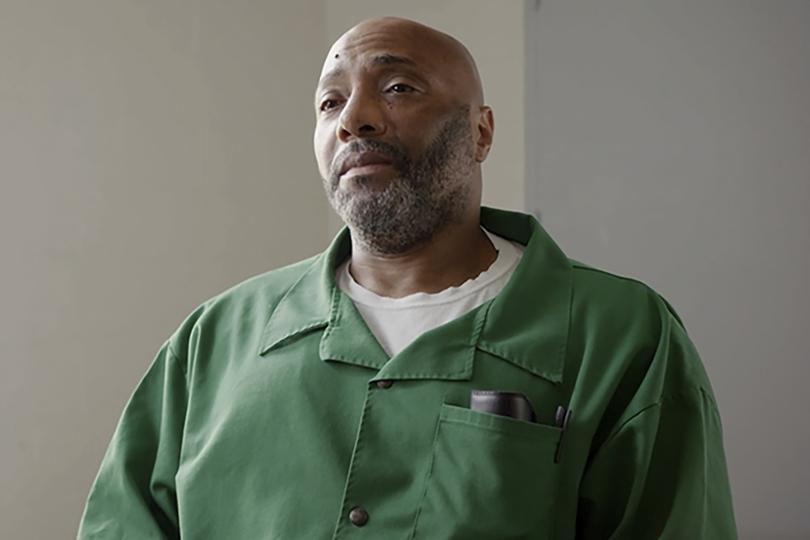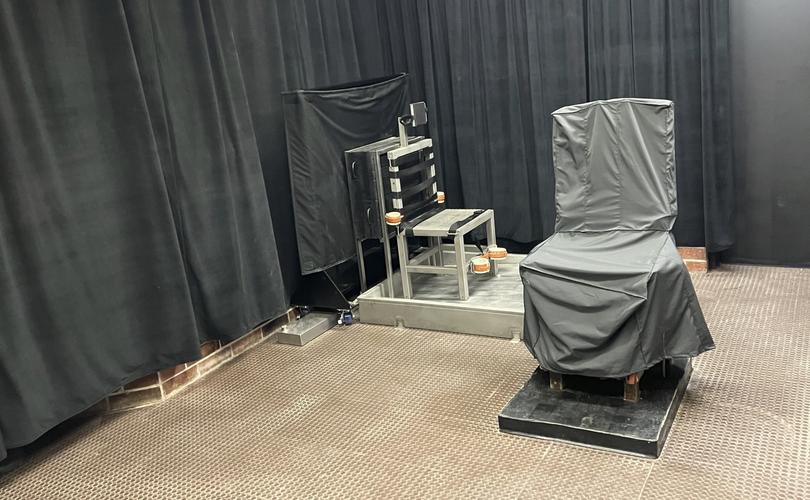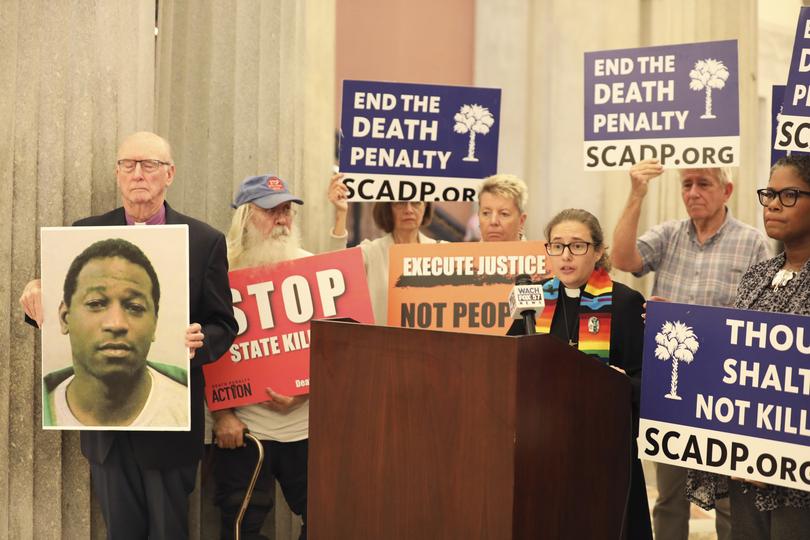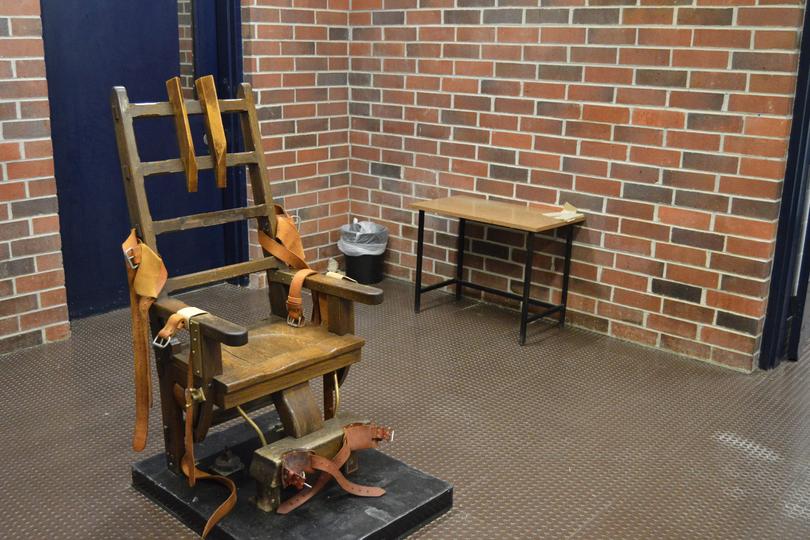Richard Moore: Barbaric choice facing death row killer - lethal injection, firing squad or electric chair?

Richard Moore claimed he had little choice but to kill James Mahoney when the store assistant pulled a gun on him inside a convenience store in Spartanburg County, South Carolina.
Moore had gone into Nikki’s Speedy Mart unarmed one day in September 1999 to steal money to buy crack cocaine.
When Mahoney brandished a pistol at him, Moore wrestled the weapon from him – only for Mahoney to produce a second gun.
Sign up to The Nightly's newsletters.
Get the first look at the digital newspaper, curated daily stories and breaking headlines delivered to your inbox.
By continuing you agree to our Terms and Privacy Policy.The men shot at each other: Moore was wounded but Mahoney was hit fatally in the chest.
Twenty-five years later, Moore does have a choice. Only this time it is a suitably macabre one for a convicted murderer.
He must select how he wants to die for his crime and has been given three options: firing squad, electric chair or lethal injection.
Officials told Moore, 59, this week that he has until October 18 – next Friday – to decide or he will be electrocuted by default on November 1.
Moore, like so many languishing on death row across America, has spent years arguing he shouldn’t be executed at all, and is appealing to the US Supreme Court to stop the process.
But his arguments haven’t swayed officials in the Republican southern state that was once one of the country’s busiest for executions – carrying out three a year.
However, it was forced to pause the process for 13 years in 2011 because it could no longer obtain a drug needed for lethal injection, owing to pharmaceutical companies’ concern about being identified if they supplied it.

Since condemned inmates had the legal choice between injection and the electric chair, this left the state unable to carry out the sentence.
In 2021, the state legislature offered the firing squad as an alternative, but legal challenges to both that and the electric chair – largely on the grounds that they breached the constitutional ban on “cruel and unusual punishments” – kept blocking executions.
Then, in July this year, after a law was passed allowing lethal drug suppliers to remain anonymous, the state’s high court ruled that prisoners could pick between the three execution methods.
South Carolina Corrections Director Bryan Stirling has written to Moore to provide some reassurance about the options.
The state’s electric chair dates back to 1912 but was tested last month and found to be working, he said.
Its firing squad has the guns, ammunition and training it needs, while the lethal injection drug was tested and found pure by technicians at the state crime lab.
Electrocution was introduced in the US more than a century ago to replace hangings (the UK similarly looked into adopting ‘Old Sparky’, as it was nicknamed across America, but never did).
Some components of the original 112-year-old wooden chair are still in use, although a prison official says the electrical parts have been “updated as needed”.
Although the state has not disclosed specific information about the chair, details revealed in court confirm that, after being strapped in, electrodes are connected to the condemned’s head and legs, including a helmet lined with copper wire, and an executioner – possibly wearing a black hood – turns a key to start the system.
Once it has warmed up, a push of a button will deliver the first of three jolts of electricity, starting at 2000 volts for 4.5 seconds, then – if death hasn’t occurred – 1000 volts for eight seconds and 120 volts for two minutes.
In other states that have recently used the chair, the prisoner’s head and legs are first shaved to reduce resistance to electricity while some wear nappies as electrocution often causes involuntary defecation or urination.
Sponges soaked in brine (a better electricity conductor than fresh water) have been strapped around the ankles and scalp.
Meanwhile, South Carolina’s firing squad consists of three volunteers from the prison guards who, after meeting “certain qualifications” that officials haven’t specified, have been trained to fire a single round at a target placed on the heart from 15 feet (4.6 metres) away.
Unlike in other states which put a blank round in one of the guns, each of the three is issued with live ammunition.
The state has spent more than £40,000 (AUD$77,400) adapting its death chamber at a prison in its capital city of Columbia to cater for death by bullet.
A metal chair has been installed in a corner of the chamber which sits within a large metal tray – probably to catch the blood.
A rectangular box directly behind the chair is designed to absorb the bullets.

After being allowed to make a final statement, the prisoner is strapped into the chair and a hood placed over their head.
The firing squad point their rifles through a hole cut in a brick wall, allowing them to remain out of view of official witnesses, who are behind bulletproof glass.
An execution team member will place a “small aim point” over the inmate’s heart, and after the prison warden reads the execution order, they will open fire.
A doctor will then examine the body to confirm death.
Two years ago, a court hearing revealed the state wanted to use “fragmentation”’ bullets which break up inside their target, causing greater damage but providing a more “instantaneous” death than conventional solid rounds.
But death by lethal injection, introduced across the US from the 1970s as a means of providing painless executions, is South Carolina’s most used method.
It previously involved a cocktail of drugs that sedated the condemned and then stopped the heart, but the state has now started using a sedative, pentobarbital, often used to put down pets.

The prisoner is strapped to a bed with only his neck free to move. The executioner, hidden in another room, injects the fatal dose through an intravenous tube attached to the arm.
There’s no indication yet which execution method Richard Moore will select, if indeed he selects any.
South Carolina has already given another death row inmate, convicted killer Freddie Owens, the three-way choice and he decided his lawyer, Emily Paavola, should choose because his doing so would be “akin to suicide”.
She selected lethal injection, which was administered to Owens last month after he was given his final meal, for which he chose two cheeseburgers, French fries, a well-done ribeye steak, six chicken wings, two strawberry sodas and a slice of apple pie.

Each method has its advocates, but all three have attracted accusations that prisoners can suffer prolonged deaths that are not only unconstitutional but also inhuman.
As Justice John Few put it in this year’s South Carolina Supreme Court decision that allowed all three methods: “We start by acknowledging the reality that there is simply no elegant way to kill a man.”
However, Chief Justice Don Beatty insisted the electric chair and firing squad are both cruel.
There was no guarantee a firing squad would precisely target the heart, he said.
Autopsy photos of some prisoners killed by firing squads have shown shots that miss the heart, which could lead to the condemned bleeding to death slowly.
Chief Justice Beatty noted that the electric chair had historically involved “prisoners being engulfed in flames, suffering extensive burns, and bleeding prior to death”.
He said the electric chair was the modern equivalent of burning someone at the stake.

South Carolina senator Dick Harpootlian, a former prosecutor, has argued the firing squad is more humane than the electric chair, after watching one electrocution in which the prisoner’s “blood boiled, his hair almost caught on fire, his eyes . . . I think they did explode in his head”.
He added: “And it wasn’t that quick. They had to give him two jolts.”
But is that any worse than the suffering of Michael Elkins, whose 1997 execution by lethal injection in South Carolina involved executioners prodding him for nearly an hour to find a suitable vein to insert the catheter?
At one point, he even tried to help them, asking: “Should I lean my head down a little bit?”
After numerous failures, they finally had to use one in his neck.
Convicted killer Richard Moore may not ultimately care how he goes but, nonetheless, the choice is hardly an easy one.
